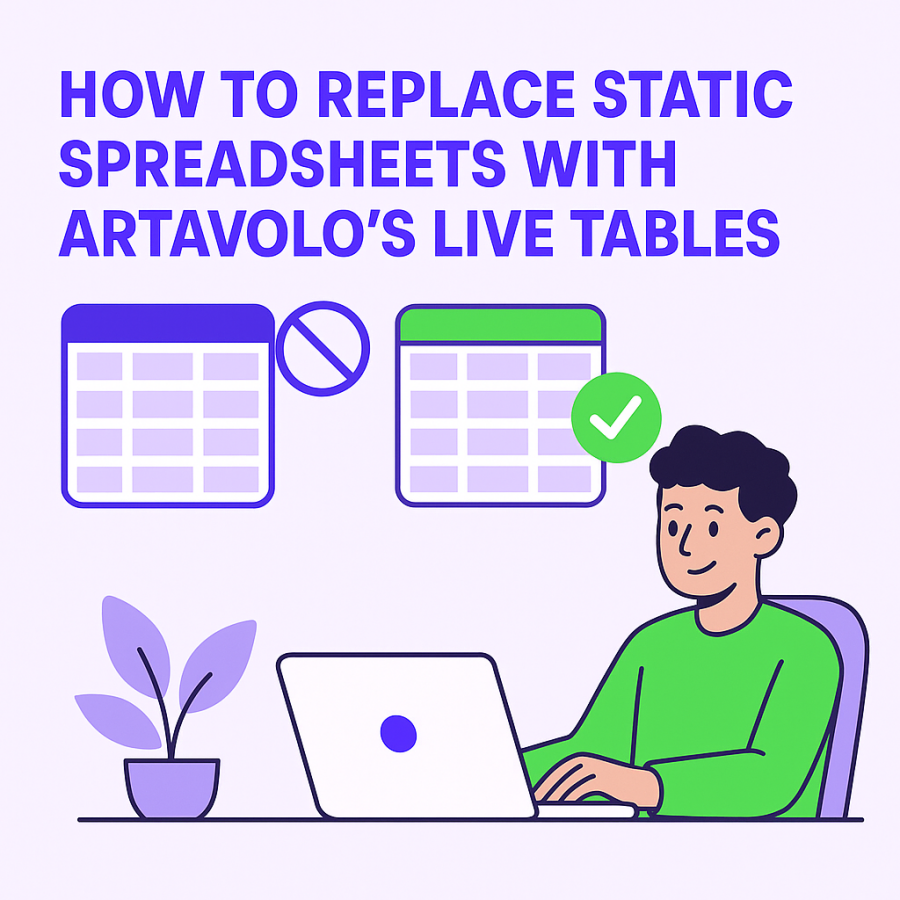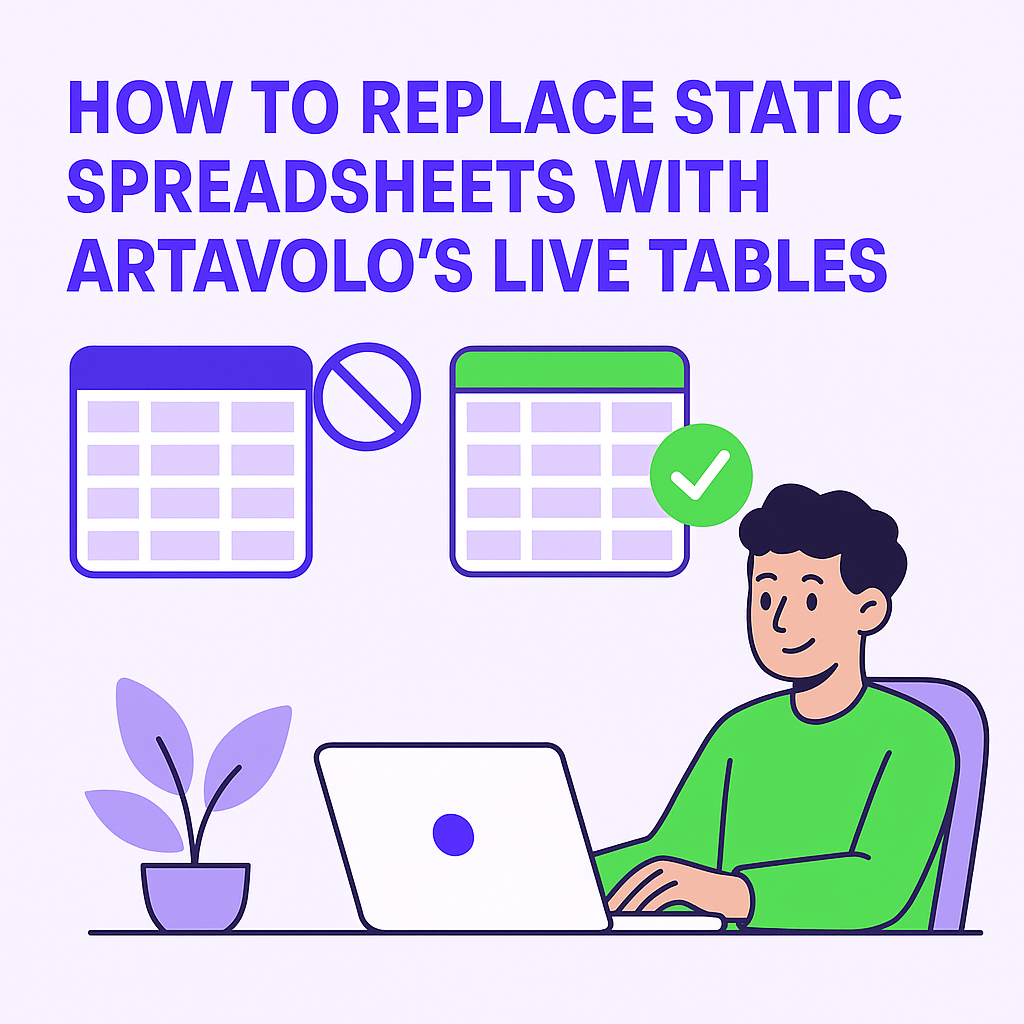In the dynamic world of modern project management, reliance on static spreadsheets remains a common yet increasingly outdated practice. Organizations continue to use spreadsheets for project planning, tracking, and budget management, despite inherent limitations such as poor collaboration, error-prone calculations, and the challenge of maintaining real-time updates. As enterprises seek to optimize efficiency with AI-enhanced tools, Artavolo, an innovative AI-powered project management software, offers an advanced alternative: live tables. This article explores how Artavolo's live tables can effectively replace static spreadsheets to revolutionize project workflows, improve accuracy, and foster seamless collaboration.
Introduction
Spreadsheets have long served as the backbone of project management documentation. Their accessibility and familiarity make them an attractive choice for many project managers. However, static spreadsheets lack the agility and intelligence required for today’s fast-paced, data-driven environments. They pose risks related to version control issues, delayed updates, and limited scalability.
Artavolo emerges as a leading AI project planning tool designed to address these challenges by offering live tables, automation, and intuitive dashboards that improve decision-making and team coordination. Throughout this comprehensive article, we will analyze the disadvantages of traditional spreadsheet-based approaches, evaluate how Artavolo's live tables serve as a superior project management solution, and demonstrate practical use cases emphasizing this transformative shift.
1. Limitations of Static Spreadsheets in Project Management
Spreadsheets, while widely used, come with significant drawbacks that impede efficient project management:
1.1 Lack of Real-Time Collaboration and Updates
- Version Conflicts: Multiple users editing different copies lead to confusion and data inconsistencies.
- Delayed Synchronization: Changes are only visible after manual updates or file sharing.
- Communication Bottlenecks: No integrated communication channels, increasing overhead in coordination.
1.2 High Risk of Data Entry Errors
- Manual Input Dependency: Spreadsheets often rely on manual data entry, causing frequent errors.
- Formula Breakage: Complex formulas are susceptible to corruption due to accidental changes.
1.3 Restricted Automation and Workflow Integration
- Limited Triggered Actions: Static spreadsheets lack native automation for progress tracking or reminders.
- Isolated Data Silos: Difficult to integrate with other project tools for streamlined workflows.
1.4 Scalability and Usability Challenges
- Performance Lag: Large spreadsheets often degrade performance and responsiveness.
- User Interface Complexity: Managing multiple sheets and tabs complicates user experience.
2. Introducing Artavolo’s Live Tables: A New Paradigm in Project Management Software
Artavolo's live tables redefine project data management by delivering:
- Real-Time, Dynamic Tables: All team members access synchronized data with instant updates.
- AI-Enabled Automation: Smart suggestions, predictive analytics, and auto-scheduling reduce manual workload.
- Integrated Dashboards: Visualize KPIs and milestones via customizable, interactive interfaces.
- Collaborative Ecosystem: Embedded communication and task assignment enhance teamwork efficiency.
2.1 What Are Live Tables?
Live tables in Artavolo function as intelligent project data repositories that update dynamically across all user interfaces. Unlike conventional spreadsheets, these tables are embedded within the project management ecosystem, allowing:
- Automated data validation and error checking
- Real-time updates and status synchronization
- Integration with AI project planning algorithms
This approach eliminates manual file-sharing cycles and outdated versions, facilitating continuous progress monitoring and transparency.
2.2 Usability and Intuition
Artavolo's interface offers a familiar tabular layout augmented with user-friendly features:
- Drag-and-drop customization of columns and rows
- Inline editing with context-aware menus
- User-specific views for roles such as PMs, team members, and stakeholders
Consequently, teams can onboard rapidly without sacrificing sophistication or control.
3. Key Advantages of Using Artavolo’s Live Tables Over Static Spreadsheets
3.1 Increased Collaboration and Communication
Artavolo eliminates common collaboration pitfalls affiliated with spreadsheet use:
- Simultaneous Multi-User Editing: Multiple contributors work concurrently without version conflicts.
- Integrated Comments and Notifications: Discussions are embedded directly within relevant table rows.
- Permission Controls: Assign granular access rights to ensure data security.
3.2 Enhanced Automation and AI-Powered Project Insights
Artavolo leverages artificial intelligence to:
- Automatically update task completion statuses based on input data
- Predict potential project risks and suggest mitigation strategies
- Generate optimized resource allocation and schedule forecasts
3.3 Real-Time Data Updates and Accuracy
Live tables ensure that all project stakeholders have access to contemporaneous information:
- Eliminate delays caused by manual spreadsheet propagation
- Reduce human calculation errors through AI validation
- Improve confidence in reporting and strategic decisions
3.4 Scalable and Customizable Dashboards
Artavolo transforms tabular data into interactive dashboards, enabling:
- Visual tracking of milestones, deadlines, and workload balance
- Drill-down analytics for in-depth performance evaluation
- Tailored views based on departmental or individual needs
4. Practical Use Cases: Transitioning from Spreadsheets to Artavolo’s Live Tables
4.1 Large-Scale Construction Project Management
Construction projects often rely heavily on spreadsheets for budget tracking, resource allocation, and timeline management. Transitioning to Artavolo allows:
- Real-time updates from field teams feeding directly into cost and schedule tables
- AI-driven risk assessments highlighting potential delays or budget overruns
- Collaborative adjustments by engineers, architects, and managers without manual consolidation
4.2 Software Development Sprint Planning
Agile teams typically use spreadsheets to outline sprint backlogs and track task progress. Artavolo’s live tables enhance this by:
- Facilitating live status updates reducing sprint planning overhead
- Providing AI suggestions for workload rebalancing based on developer capacity
- Integrating automated notifications when blockers or delays appear
4.3 Marketing Campaign Coordination
Marketing teams manage complex campaigns using spreadsheets for timelines, budgets, and deliverable tracking. Using Artavolo:
- Live tables synchronize creative progress with budget spend in real time
- Dashboards allow executives to visualize ROI and campaign channels immediately
- AI-powered insights uncover potential bottlenecks or audience segment overlap
5. Transition Strategy: Implementing Artavolo Live Tables in Your Organization
5.1 Assessment of Existing Spreadsheet Workflows
Begin with a thorough audit of current spreadsheet usage to identify:
- Critical data sets and processes needing migration
- Areas prone to errors or delays due to manual updates
- Stakeholders involved and permission requirements
5.2 Data Migration and Table Setup
Artavolo facilitates import of existing spreadsheet data into live tables with mapping features to preserve structure. Follow these steps:
- Import raw data
- Configure live table schemas reflecting project parameters
- Define calculated fields and validation rules
5.3 Training and User Adoption
Promote user buy-in through:
- Hands-on training sessions demonstrating live collaboration
- Showcasing AI features that save time and reduce errors
- Encouraging feedback for continuous platform improvement
5.4 Integration with Existing Project Management Software
Artavolo supports seamless integrations allowing hybrid workflows during transition phases:
- Connecting live tables to task boards and calendars
- Syncing with communication tools to embed discussions inside tables
- Utilizing APIs for custom automation pipelines
6. Comparative Analysis: Artavolo’s Live Tables vs Traditional Tools
| Feature | Static Spreadsheets | Artavolo Live Tables |
|---|---|---|
| Real-Time Updates | No, updates are manual and asynchronous | Yes, instantaneous updates across all users |
| Collaboration | Limited, prone to version conflicts and communication gaps | Robust, with multi-user editing and integrated chat/comments |
| Automation | Minimal to none, dependent on manual formulas | Advanced AI-powered automation and predictive analytics |
| Data Integrity | High risk of human error and broken formulas | Built-in validation and error detection |
| Dashboards & Visualization | Requires external tools or manual charting | Integrated, customizable dashboards with live data feeds |
| Scalability | Performance degrades with size and complexity | Designed to scale efficiently with growing projects |
7. The Role of AI in Modern Project Management with Artavolo
Artavolo exemplifies the next generation of modern project management software by embedding artificial intelligence into core functionalities that were previously manual and error-prone:
- Predictive Scheduling: AI algorithms forecast potential delays and suggest optimal adjustments.
- Resource Optimization: Machine learning analyzes workload distribution to ensure balanced task allocation.
- Intelligent Reporting: Automated generation of status reports customized to stakeholders’ needs.
- Natural Language Processing (NLP): Smart assistants help interpret project notes and recommend actions.
By incorporating these advanced capabilities, Artavolo empowers teams to stay proactive, minimize risks, and drive project success.
Conclusion
Organizations committed to efficient, error-free, and adaptive project management must evolve beyond static spreadsheets towards intelligent, collaborative tools. Artavolo’s live tables represent a fundamental shift, combining real-time data synchronization, AI-powered automation, and comprehensive visualization to overhaul traditional project planning workflows. Through practical applications across industries—ranging from construction and software development to marketing—Artavolo demonstrates marked improvements in usability, collaboration, and project outcomes.
As the landscape of project management software increasingly demands agility and data intelligence, embracing Artavolo’s live tables is a strategic move for forward-thinking organizations. To experience the benefits of this innovative AI project planning tool, consider integrating Artavolo into your operational frameworks and drive your projects with clarity, precision, and confidence.

